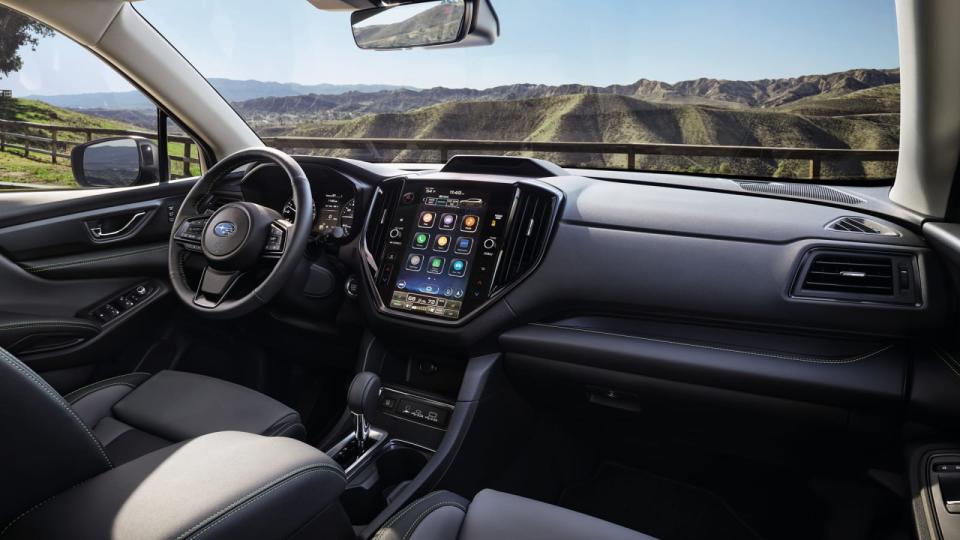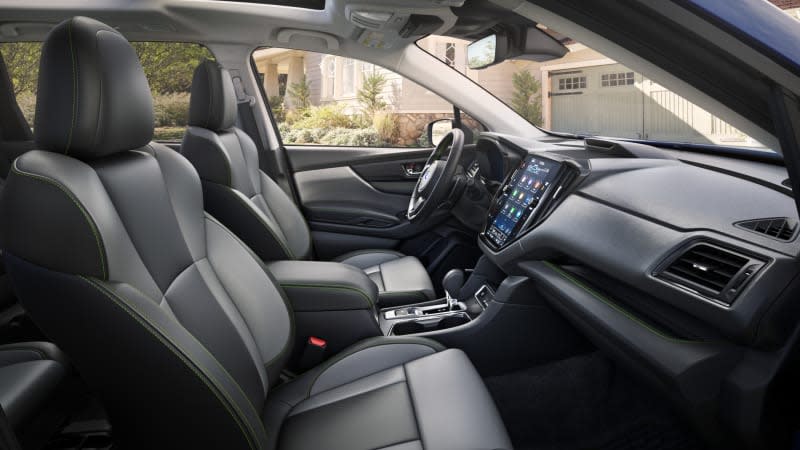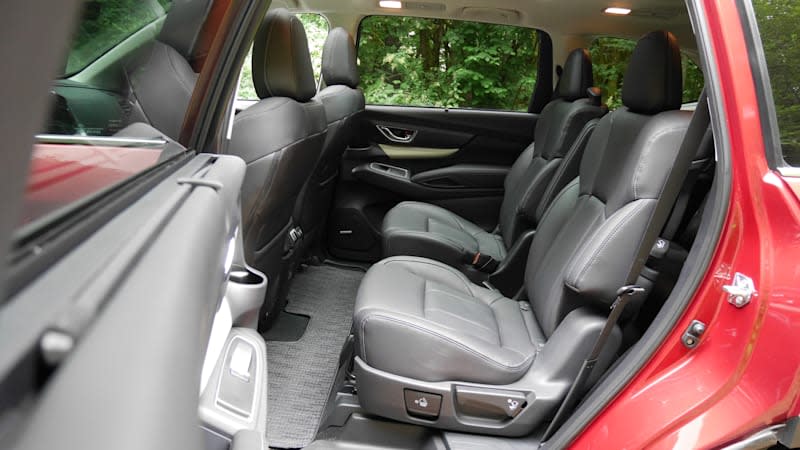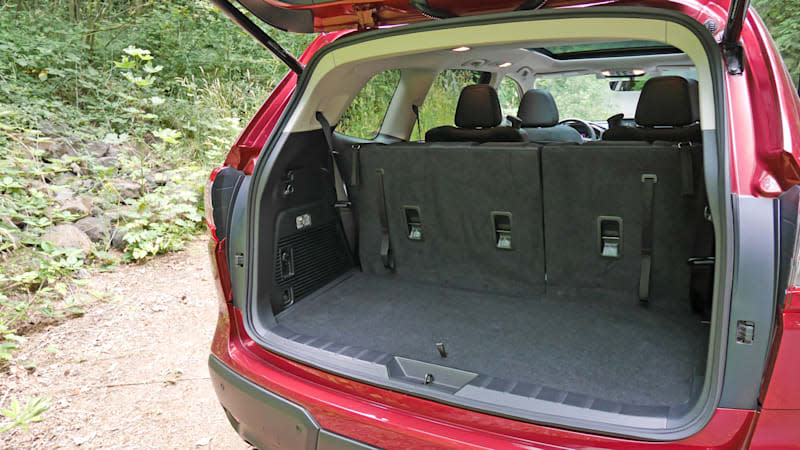2023 Subaru Ascent Review: For those who've outgrown an Outback

Pros: Standard all-wheel drive; above-average ground clearance; useful roof rails; simple controls; great visibility
Cons: Plain interior; disconnected driving experience; helicopter parent safety tech
Even with noteworthy updates this year, the 2023 Subaru Ascent doesn’t really stand above and beyond the crowded field of three-row family crossovers. Oh, it comes standard with all-wheel drive and more ground clearance than most, but it’s hardly the rugged mountain goat of family crossovers. There are also those that make a bolder statement outside, that are more luxurious inside and that are better to drive. Some are even more spacious or versatile. Frankly, it’s hard not to point most buyers towards a Kia Telluride, Hyundai Palisade or Toyota Highlander Hybrid instead.
The thing is, though, the Ascent really isn’t for the general three-row crossover-buying population. It’s for Subaru’s fiercely loyal customers, and specifically the great many who outgrow their Foresters and Outbacks. Admittedly, that’s an awful lot of people these days given Subaru’s constantly increasing popularity. And with the Ascent, they’ll get loads of extra space, but with the same 8.7 inches of ground clearance, beefy roof rails, user-friendly controls and no-nonsense cabin design. The Ascent even drives like an Outback, which isn’t always a good thing, but at least it’ll be familiar. At the same time, even if you’d be a newbie to the Subaru brand, there’s no reason you couldn’t become just as enamored with those same traits, especially if you have a knack for taking outdoorsy adventures.
Interior & Technology | Passenger & Cargo Space | Performance & Fuel Economy
What it's like to drive | Pricing & Trim Levels | Crash Ratings & Safety Features
What's new for 2023?
The Ascent gets notable revisions for 2023. Updated styling attempts to create a more squared-off, rugged appearance with a bigger grille and more aggressively shaped headlights. Basically, it looks less like a gigantic Outback now. Inside, however, it actually looks more like an Outback thanks to the new vertically oriented touchscreen borrowed from Subaru’s crossover wagon. Wireless Apple CarPlay and Android Auto are now standard as well. The EyeSight driver assistance technology suite was upgraded with upgraded sensors and software to apparently operate more smoothly and in a wider range of conditions. This includes a camera better able to detect pedestrians and cyclists. Those Ascents with blind-spot warning also gain automatic emergency steering assist. Finally, a new Cabin Connect function picks up the driver’s voice and transmits it over the rear speakers for the kids in the back to properly hear such things as “don’t make me stop this car!”

What are the Outback interior and in-car technology like?
From the driver's seat, the Ascent's packaging displays Subaru's pragmatic philosophy to car design. All the gauges are easy to see and read at a glance, knobs and buttons are easy to locate — both those of the software-based touchscreen infotainment system and the physical ones on the steering wheel and center stack. There aren't as many clever cubbies as in a Hyundai Palisade or Toyota Highlander, but there are a grand total of 19 cupholders spread throughout the cabin. Anticipate frequent bathrooms stops.
In terms of design, we can’t say the interior is that attractive, especially when compared to the Palisade, Highlander, Telluride, CX-9, Pathfinder … So yeah, almost everything. The jumbo portrait-style tech interface added for 2023 hardly improves things, but at least it’s all in keeping with Subaru’s no-nonsense vibe. Even that touchscreen’s graphics are on the sensible side, with big, easily identified and pressed virtual buttons. It’s not fancy, but it works well – which could probably be an unofficial Subaru slogan. Materials quality is agreeably average, and although it doesn’t quite achieve the premium vibe of all those rivals, the pops of color and dash-covering pleather are appreciated touches.
All of that said, should you be ascending to the Ascent from something else in the Subaru lineup, you’re going to feel absolutely at home. This is especially true now that the Ascent shares the Outback’s tech interface – there’s no chance you’ll feel shortchanged by Subaru’s biggest and priciest model not having access to the latest-and-greatest features.


How big is the Ascent?
For those already in the Subaru family, the Ascent represents a clear step up from the brand's other crossovers. It is 5.5 inches longer than an Outback, 3 inches wider and 5.2 inches taller. It's a whopping 14.7 inches longer than a Forester, 4.5 inches narrower and 3.5 inches shorter. It also has an extra row of seats. Compared to other three-row crossovers, however, its dimensions are average apart from being taller than most. This is partly because of its class-leading 8.7 inches of ground clearance, but also just because of its tall, boxy greenhouse.
A 6-foot passenger will have plenty of room in the second row, which is adjustable for legroom and seatback angle. On upper trim levels, buyers can choose between a pair of captain's chairs or a three-passenger bench. We've found that they're basically equal in terms of comfort. Third-row passengers are treated better in the Ascent than in many competitors (Toyota Highlander, Mazda CX-9 and Ford Explorer in particular). If the middle-seat occupants are willing to slide their seats forward a bit, there's adequate legroom for a 6-footer in the way back to sit comfortably for a fair bit of time. For kids, this means even more comfort and space.
As for cargo, the Ascent offers 17.6 cubic feet of cargo space behind the third row, which is mid-pack for this segment. It’s more than the Mazda CX-9 (14.4 cubic feet), Toyota Highlander (16.0) and outgoing Honda Pilot (16.5), but less than the Hyundai Palisade (18.0), Ford Explorer (18.2), VW Atlas (20.6) and Kia Telluride (21.0). Max cargo volume is among the class leaders at 86.5 cubic feet, which is almost certainly the result of being quite boxy – always a good thing when it comes to cargo. For anything that doesn't fit inside, the Ascent has big, extra-functional roof rails for whatever racks, carriers and other accessories you might have. And believe us, Subaru owners tend to have them.




What are the Ascent fuel economy and performance specs?
The Ascent’s sole powertrain offering is a 2.4-liter turbocharged four-cylinder engine, arranged in Subaru’s signature boxer (horizontally opposed rather than a V or inline) configuration. Power is sent to all four wheels via a continuously variable transmission (CVT). Producing 260 horsepower and 277 pound-feet of torque, we've found this engine can feel just as quick in relaxed around-town driving as its competitors, but know that their greater outputs do result in quicker 0-60-mph times and more robust acceleration when fully loaded.
That said, owners living at higher elevations (as many Subaru owners do) will appreciate the lasting power from the turbocharger, which keeps the Ascent from feeling breathless at heights where naturally aspirated engines start to lose power. In other words, four cylinders are not necessarily lesser than six, and it even manages the same 5,000-pound towing capacity of most rivals.
EPA fuel economy estimates were not available at the time of this writing, but as there were no powertrain changes indicated for 2023, it seems unlikely they will change much from the following 2022 estimates. The ’22 Ascent returned 21 mpg city, 27 mpg highway and 23 mpg combined, while the Limited, Touring and Onyx Edition returned 20/26/22.

 Yahoo Autos
Yahoo Autos 
